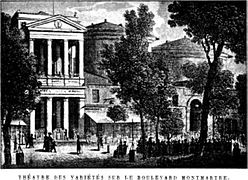|
Jacques Cellerier Grave at Père Lachaise cemetery Jacques Cellerier (1742–1814) was a French architect in the neoclassical style whose buildings can be seen mainly in Paris and Dijon. LifeBorn in Dijon, son of innkeepers, a student of Nicolas Lenoir, to whom he was related, he continued his training at the Académie royale d'architecture. Together with his friend the sculptor Jean-Antoine Houdon, he was pensionnaire du Roi in Rome before being appointed engineer of the Généralité of Paris. His work was mainly focused on private mansions and theatres. A supporter of the Lumières, he drew the imposing funeral chariot that carried the ashes of his friend Voltaire to the Panthéon in 1791. In 1790, he made the drawings for the triumphal arch of the Champ-de-Mars for the Fête de la Fédération. In 1800, on the occasion of the celebration of the Treaty of Mortefontaine between France and the U.S, he proceeded to the restoration of the theatre of the Château de Mortefontaine.[1] In 1807, Napoleon I charged him with the task of erecting a monument to the glory of his victories over the English and Russians. He was finally replaced for this project by Jean-Antoine Alavoine. In 1812, Napoleon entrusted him with the project of building a palace of the Archives, the first stone of which was laid on August 15, Saint Napoleon's Day, the Emperor being in the middle of the Russian campaign in front of Smolensk. This palace of the Archives was to be located in the new administrative district designed by the Emperor and was to face the Palace of the King of Rome, at one of the four ends of the Champ de Mars, at the east and along the river Seine.[2] Its realization was to be entrusted to Cellerier.[3] The events of 1815 and the fall of the Empire, however, put an end to this project, which remained unfinished. In 1813, he used again the gothic style for the first time since the completion of the Cathédrale Sainte-Croix d'Orléans, at the Basilica of Saint-Denis, which was endowed with a richly decorated Gothic chapel. Cellerier also built a neoclassical winter choir. Gallery
RealisationsIn Paris
In Dijon
In Maisons-Alfort
In Compiègne
In Tremblay-en-France
In Châtenay-en-France
In Saint-Germain-en-Laye
References
External links
See alsoWikimedia Commons has media related to Jacques Cellerier. |





